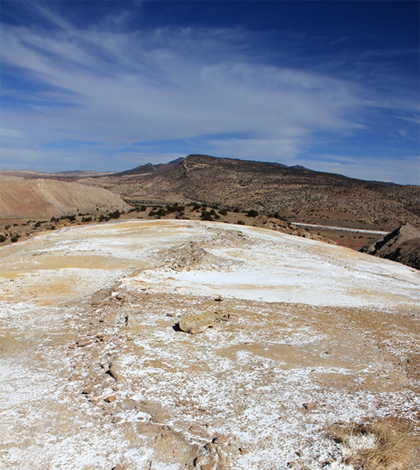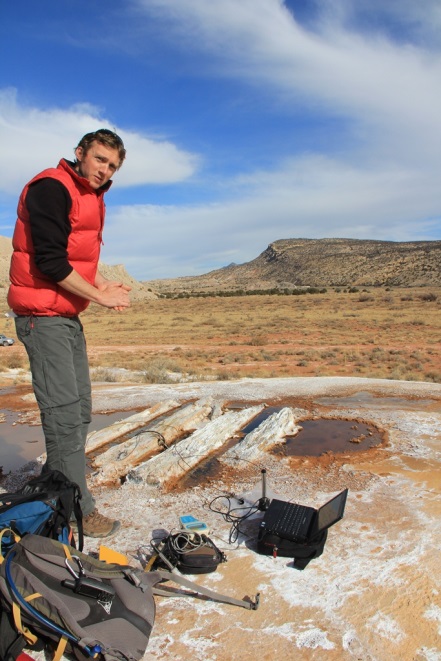As New Mexico snowpack shrinks, high-salinity groundwater looms as water quality issue

View from the top of the spring mounds near San Ysidro, N.M., looking north toward the Nacimiento Range. The range is bounded on the west by the Nacimiento Fault. In the foreground is the fissure along which the springs are aligned. (Credit: Laura Crossey)
Climate projections for the Southwest United States say the region should expect diminished snow pack. That’s a concern for water managers as they prepare to supply a growing population with shrinking water resources. But scientists in New Mexico are hoping to learn more about what it could mean for water quality.
Melting snow contributes to the region’s surface water flows, but so does deep groundwater bubbling up through faults. That groundwater can be low in oxygen and high in salinity and trace metals.
“In the arid Southwest, where we have things like relatively young volcanos and geothermal systems, you have the opportunity for waters to come from the subsurface and to mix with the surface water systems,” said Laura Crossey, professor in the Department of Earth and Planetary Sciences at the University of New Mexico.
“It’s not rocket science to say as we look into a future scenario where we might have less and less snowpack, then we’ll see years where the water is more saline and has these other constituents in it on a more frequent basis than it does today.”
To get a clearer picture of just how saline and metal-tainted the water might become, Crossey and her colleagues are monitoring water quality in streams and springs in a fault-crossed region of New Mexico. By measuring ongoing variation in salinity and other chemical parameters in these waters and relating that to discharge, Crossey says they’ll be able to forecast water quality changes under various climate scenarios.
“That’s kind of where we’re trying to head: finding ways that we can use monitoring to couple hydrochemical parameters to hydrologic parameters and then be able to work better with managers to think about water quality, not just water quantity,” Crossey said.
The group’s study sites include streams on the Valles Caldera, a volcano that most recently erupted over a million years ago. That makes it a relatively young feature with active geothermal systems, Crossey said. Water sneaks up through those systems and enters streams as they cross faults, diminishing the surface water quality as it heads down the slope.
Crossey and her research group have extensively monitored the Jemez River, which drains the caldera. That includes data collection though mutli-parameter sondes measuring temperature, salinity, pH and dissolved oxygen. She’s also deployed simpler sensor setups that measure conductivity, temperature and depth. They’ve supplemented that with traditional sampling and laboratory analysis to determine other constituents like sulfate and arsenic.
All of that comes together to allow the researchers to build relationships between stream flows to elements of water quality.
“I have a very nice, coherent set of results that show that, once you understand the system, the combination of stream level and conductance lets you understand what the arsenic concentration will be, for example,” Crossey said.
That’s especially useful because modelers are already building tools to project how streamflows will respond to potential climate scenarios. Crossey’s research can add use the results of those models to project what some water quality parameters are going to look like.

UNM graduate student Christopher McGibbon preparing to deploy monitoring equipment. (Credit: Laura Crossey)
South of the Valles Caldera, Crossey and master’s student Chris McGibbon have installed conductivity, temperature and depth sensors in a series of springs rising from the Nacimiento Fault. Data from this site gives a clean look at water coming up from the fault before it mixes with surface water. The sensors are also giving researchers their first chance to understand what’s driving slow changes in the water quality there. So far, they’ve detected slight seasonal temperature variations one one or two degrees Celsius. They’ve also seen more frequent salinity variations.
“There are many reasons that temperature might change. There are many reasons that conductance might change,” Crossey said. “And if we monitor both of them, we can sometimes attribute how much of the change is from one process and how much is from another.”
By advocating for this kind of monitoring Crossey is hoping to emphasize the importance of water quality as managers being to cope with approaching climate-driven water supply issues. Meanwhile, as part of the university system that works with students, she’s also helping to train the next generation of environmental scientists to work with the sensors high-resolution datasets that are becoming increasingly important in this kind of research.
“We’re feeling the crunch of the new things that we need to be teaching students so that when they go out they’re able to have the skills to take advantage of this monitoring,” she said.





0 comments